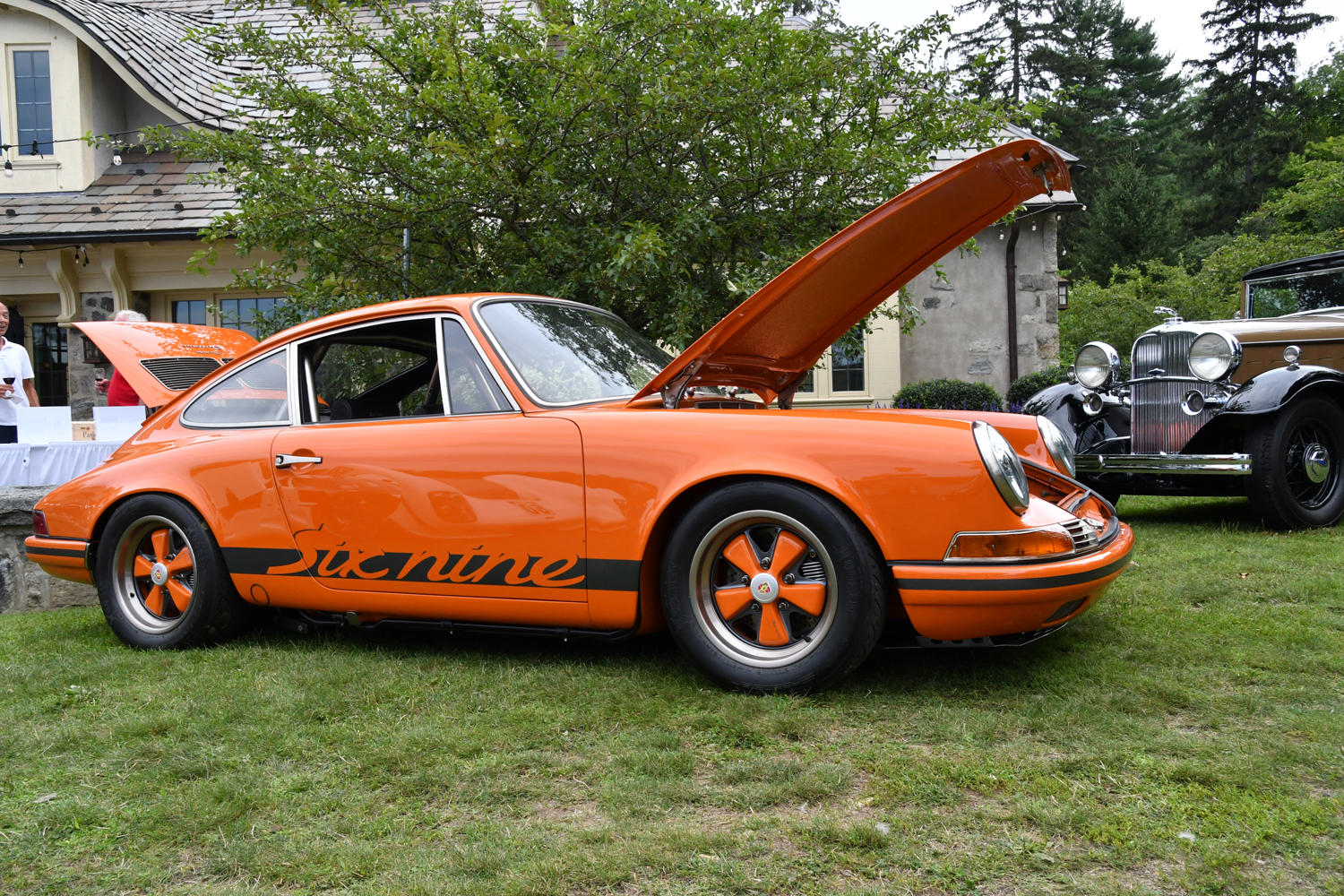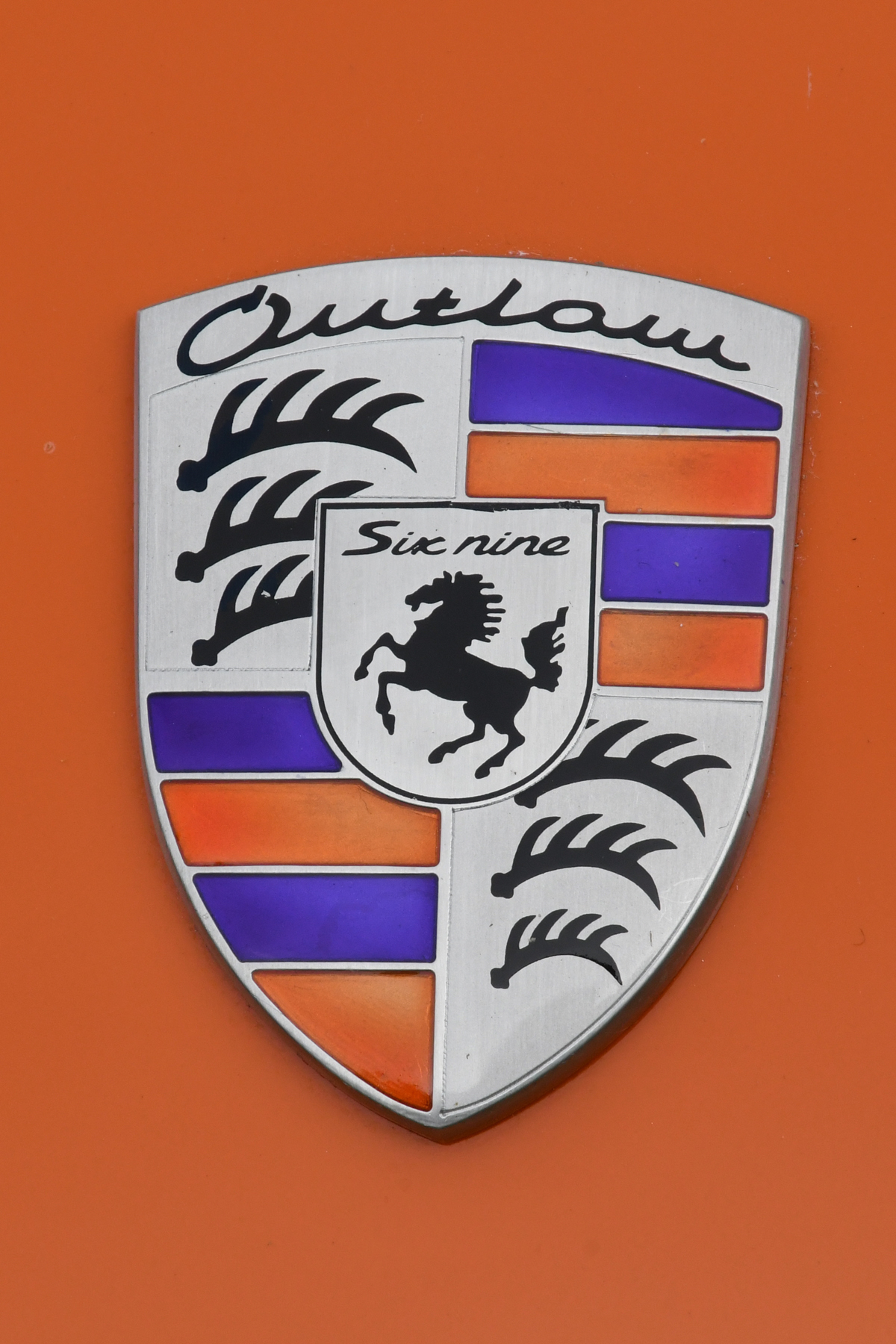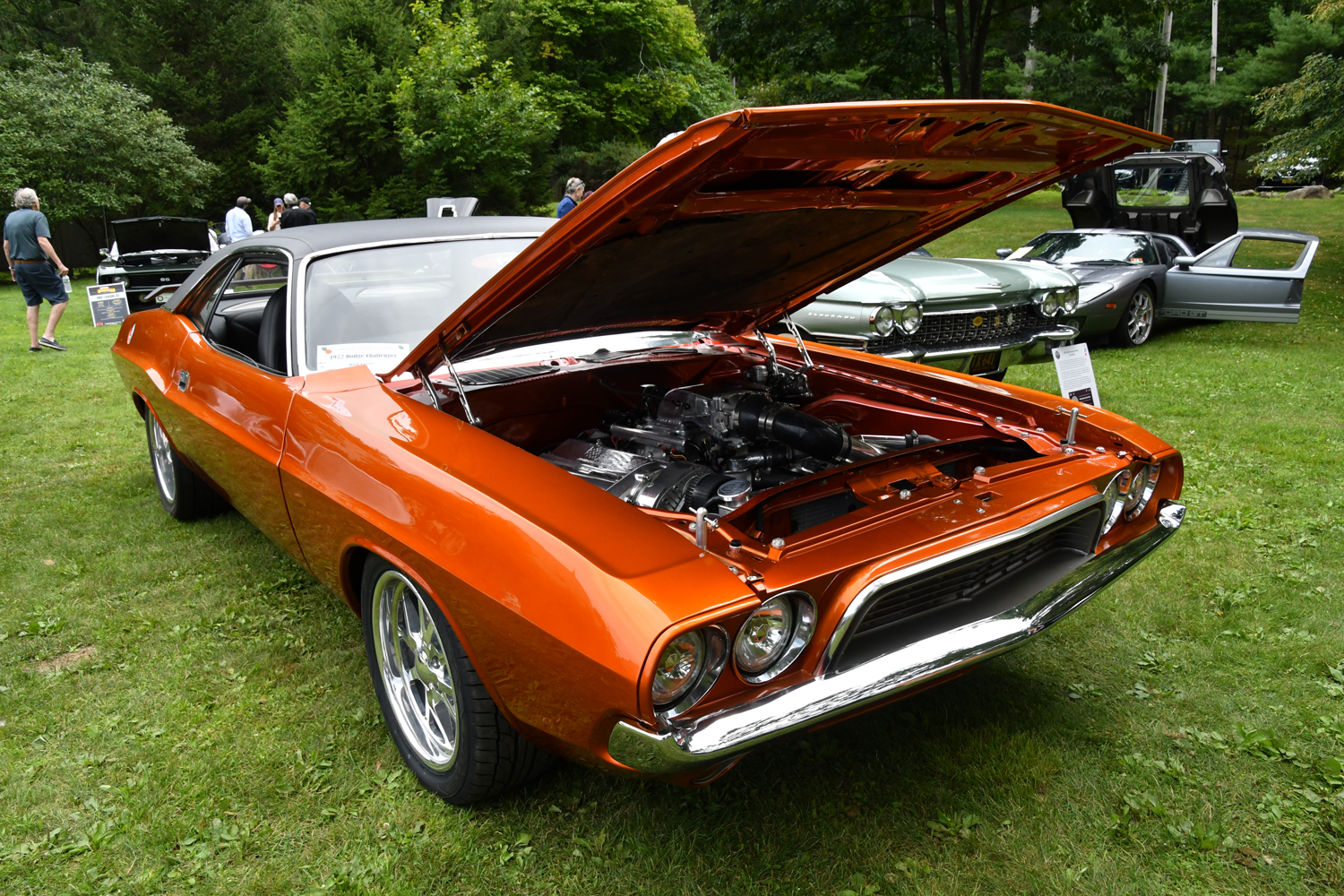Crossing from New Jersey and meandering north on old Route 17 surrounds one with a picture of a region that for decades lived frozen in a faded past but recently began experiencing a quantum leap into the now. Still very much a work in progress, the scene along Route 17 features stretches of old buildings tightly snugged up against a patchwork paved narrow four-lane. Safely navigating the bumps, twists and turns demands a firm hand on the wheel and a steady eye on fellow drivers often found wandering about the narrow lanes.
Clearly, this trek offers a decidedly unglamorous journey on the way to enjoying an extraordinary classic car experience. Today the grounds of an architectural pearl of the Gilded Age will feature a delightfully understated concours.
Approaching the handsomely crafted stone guard station, I am waved though. I have entered an enclave of aesthetically integrated architectural and natural beauty born in the 1880s. I have entered a world worthy of a modern day Gatsby. Navigating the winding country roads leads me to the manicured grounds of the Tuxedo Club in Tuxedo Park, NY.
Bring what you love

Tuxedo Club “Field of Driving Dreams” registration

Gordon Borteck with his Pantera
Raising its German voice with the elevated revs courtesy of a downshift, my BMW descends the hill. As my trusty sports sedan hugs the curve of the narrow West Lake Road, the Tuxedo Club comes into view. Surrounded by a finely groomed lawn, overlooking Tuxedo Lake and set against a forested hillside, the grounds offer a spectacular backdrop on which to display priceless automobiles.
Pulling off to the side of the circular driveway at the club entrance, I am greeted by Gordon Borteck, the driving force behind the Tuxedo Concours officially titled “The Tuxedo Club Field of Driving Dreams.”
Borteck a Tuxedo Club member and guiding force behind the Tuxedo Park event conceived of the idea about eight years ago as a great Father’s Day celebration. Its instant popularity proved Borteck possessed 20/20 foresight. As with such good ideas, they exhibit a dynamic character that seeks to expand to ever greater proportions. Borteck has felt the pressure to expand which he has resisted.
 Here comes a Ferrari La Ferrari. There goes a Lamborghini Countach. Step aside for the Chaparral race car. Make room for the Bentley Continental Coupe. Make way for the BoCar. As an amazing array of predominantly iconic German, Italian, English and American rolling artwork begin to populate the lush green hillside, I had the chance to ask Borteck about his unique event.
Here comes a Ferrari La Ferrari. There goes a Lamborghini Countach. Step aside for the Chaparral race car. Make room for the Bentley Continental Coupe. Make way for the BoCar. As an amazing array of predominantly iconic German, Italian, English and American rolling artwork begin to populate the lush green hillside, I had the chance to ask Borteck about his unique event.
“I have sought to emphasize a theme of ‘bring what you love,” says Borteck, he continues, “I am not looking for the fanciest, the fastest or the oldest.” To realize his objective, Borteck has striven to achieve a feeling similar to that of an invitation only art exhibit. Borteck says, “My goal is to keep the show relatively small.” Eighty some cars comprised those invited to complete the field this year. He wants the owners to share the cars they love with the other car owners  and guests. Much like one artist discussing his work with others. He says, “I strive for the event to be both a learning experience for viewers and a teaching experience for the dedicated owners. Here, people can share with each other without crowds or craziness.”
and guests. Much like one artist discussing his work with others. He says, “I strive for the event to be both a learning experience for viewers and a teaching experience for the dedicated owners. Here, people can share with each other without crowds or craziness.”
Despite a promise of showers, the sun has come out to stay. Borteck admits he would have sold his soul to the devil for this weather. After cancelling because of Covid last year, missing a second year in a row loomed as a crushing disappointment.
The colors of the assembled “Field of Driving Dreams” entrants pops off against the verdant lawn. Colorful as well could describe many of the car Owners.
Bruce Amster – 1961 Chaparral

1961 Chaparral
Bruce Amster a classic car aficionado is no stranger to the Tuxedo event. He consistently delights with the unique entrees he brings. This year he did not disappoint by bringing a 1961 Chaparral race car. Amster says, “This Jim Hall developed Chaparral is a real race car. Race cars that look perfect and have always been perfect are not real race cars. A real race car has got to have gone through hell driven by a driver who has gone through hell.” This Chaparral truly qualifies by that standard. Built in 1961 by Troutman and Barnes, it was first driven by 2-time Indy 500 winner Roger Ward. Powered by a stroked Chevy small block with 4-wheel disc brakes and fully independent rear suspension the Chaparral presented an able competitor for facing the potent Maseratis and Listers of the day. Amster says, “The car has a great history. It was crashed by Roger Ward. Totally rebuilt it would be campaigned by a new owner and would set a lap record at Laguna Seca in 1962.” The car is still raced heavily overseas at Goodwood and Silverstone. It will be returning to England to campaign next season.
Jay Hirsch – 1960 Cadillac Eldorado Biarittz convertible

1960 Cadillac Eldorado Biarritz Convertible
Like recalling Howard Cosell at a boxing match, sighting world renowned automotive photographer and journalist Jay Hirsch at a car event goes without saying. A fixture at any meaningful classic car experience, the genial and engaging Hirsch not only photographs classic cars for calendars and books but collects them as well. At Tuxedo this year Jay brought his original Carrera Green 1960 Cadillac Eldorado Biarritz Convertible. Truly “The standard of the world” when it meant something, this stunning period piece rolling sculpture featured a 390 cu. in. V8 with three deuces and a 4-speed Hydra-Matic transmission.
For Jay his Cadillac’s story goes back to the day a family friend bought the car new. Jay says, “It was 1960 and my father bought a Fleetwood. At the same time a family friend bought this car. Years later he sold it to a friend who ran the Cyclone in Coney Island.” Back in the 1980s that friend asked Jay if he would he be interested in the Cadillac should the friend ever decide to sell it? Absolutely, came Jay’s reply. Fifteen years later Jay got the call and Jay bought the car.
Jay says, all through the years it was never driven in winter, only in the summertime on weekends. It has never been restored. Not afraid to drive it, Jay recently drove it 630 miles to Plymouth Michigan to show the car at the Concours d’ Elegance of America at St. Johns where it won “Most Original Car.”
Jay put over 1500 miles on the Cadillac for his trip. Jay says, “I cruised all day across a good stretch of America in this glorious piece of automotive history at 80 miles per hour averaging 17 miles per gallon for a 5,000 pound car. I’m happy.”
Dr. Charles Lennon – 1969 Porsche 911 Outlaw

1969 Porsche 911 Outlaw
Dr. Charles Lennon’s place in the Pantheon of vintage Porsche crazies was concretized when he chose to rebuild his house to provide for five working bays in the basement to accommodate 356 and 911 Porsche restoration. For Tuxedo, Dr. Lennon brought a 1969 911 Outlaw on which he has been working for the past four years. Just looking at the quality of work and attention to detail tells you all you need to know about how he approaches his vocation as a prosthodontist (specialist in dental restoration).

1969 Porsche Outlaw custom badge
In explaining the Porsche Outlaw concept Dr. Lennon says, “It started with John Von Neumann and his 356 Porsches back in the 1950s. Von Neumann would show up at the track with modifications such as better brakes and bigger motors. Stuff beyond factory spec. These upgraded non-factory spec’d cars became known as Outlaws.”
Dr. Lennon goes on to say that he likes to build Porsches that scare him. He loved the idea of building an Outlaw and he had the perfect subject, a 1969 911. He set his heart on building a better Porsche. He says, “Bigger brakes, bigger motor, better suspension. It would be a Porsche Plus.”
He also wanted his outlaw to honor the basic shape of his subject 911. Dr. Lennon says, No front air dams, no flares, no tails, nothing just the original shape.” Just about everything else would wear this surgeons touch. He says the brakes are 917 units that took him two years to get. The original motor swept two liters. His outlaw gets its push from a naturally aspirated twin plug 3.4 liter engine with mechanical fuel injection. Dr. Lennon says it puts out roughly 315 horsepower with a vehicle weight of 2,160 pounds. He acknowledges that remaining faithful to the body originality limits the size tire which certainly elevates the scare factor.
The detail that Dr. Lennon has put into the smallest features including the badging clearly shows it has been a labor of love. He says, for me in my lifetime this has been the best creative experience I’ve ever had.”
Rich and Chris Varjan – 1972 Dodge Challenger

1972 Dodge Challenger
Rich Varjan’s R-M three-stage orange over silver 1972 Dodge Challenger began as a project car that he found in Toronto Canada for his 14-year old son, Chris. Today, standing by the car that has experienced numerous rebuilds as the Varjans have pushed it up the performance ladder one sees Chris who is now 34 years old.
Both gregarious and genial, father and son banter back and forth as they describe the adventure in engineering that their Challenger represents. Basically its present iteration represents an eight-year trial and error journey that has culminated in a 900 horsepower well mannered beast. Well mannered that is unless, as the senior Varjan says, “You put your foot to the floor? The you buy new tires.” “But it tracks straight as an arrow,” adds son Chris Varjan, remarkably straight for what it is.”
Rich Varjan explains that at the heart of his beast of the street resides a worked 422 cu. in. low compression race block with a Procharger supercharger and electric fuel injection.
Rich Varjan speaking about the suspension says, “Front suspension is Riley with four link coilovers on all four corners and tubular control arms. It’s all Riley Motorsports.”
When asked if the project was worth the eight years, both father and son just smile.
Hank Bernstein – Zipper lakes tribute hot rod

Zipper Lakes tribute Hot Rod
“It’s a lakes modified roadster,” says owner Hank Bernstein. He has built it to pay tribute to the early post WWII southern California dry lakes racers. Before drag strips, even before Bonneville, people would bring their Model Ts and Model As out to El Mirage, take off the fenders and race all weekend. Bernstein says, “They built these cars with skills they mostly learned in the military during WWII, primarily aircraft.”
Bernstein’s tribute roadster which he built himself features some unique attributes. The strikingly handsome body and frame feature a design by Darrell Zip who used to work for Revell, the model company. Power comes from the Alfa Romeo V6 introduced in the early 1980s with the GTV6. Bernstein’s familiarity with Alfa Romeo power plants comes from his years with the Alfa Romeo engineering group.
Carburetion comes from Holley 94 carburetors found on Ford flatheads. Rather than using Strombergs that had a reputation for leaking, Bernstein travelled through four states to find five Holley 94s from which he could make three good ones. When he built the car reproductions of Holley 94s were not available. Bernstein even designed the engine turned dash. For the machining he located a retired and skilled machinist.
When asked about his creation’s top end, Bernstein says it is faster than he will ever drive it. He says, “To put it in perspective, in the 3,200 lb. Alfa GTV6 the top speed peaked around 130 mph. My roadster weighs 1,880 lbs.” The fastest Bernstein has gone in his roadster is 95 mph. Bernstein says, “ I am an old drag racer. I don’t have anything to prove.”
When asked for any final thoughts Bernstein smiled and said, “Life’s too short. Build a hot road.”

“Field of Driving Dreams” registration
While the objects of their affection differed, the prevailing sentiment at Tuxedo that day spoke with one voice and it said “Find what you love and drive it.”

Well done, Burton!
Thank you Gordon. Much appreciated.
great story, look forward every month to your new adventures
Pleased to have you as part of the Drivin’ News family